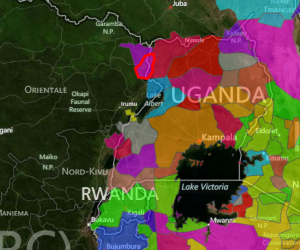In our next field visit to Northern Uganda we will come across a mix of different tribes, including The Lugbara.
Location: West-Nile regions of Uganda (we will record them during our fieldtrip in the towns of Arua and Pakwach)
Population: Around 900,000
History: They were known in the 19th century as ‘The Naked People’, due to the lacking importance of clothes in their culture. In the early days, the Lugbara were a mainly chiefdom-based community. They did not have kingdoms and kings presiding over them as like other ethnic groups in Uganda. They mainly had chiefs who were their leaders. They formed friendly alliances with neighbouring chiefdoms to ensure their security against attacks from other ethnic groups. Rather than an army, every able-bodied man had the duty to protect his village hence all able-bodied men were automatically considered a soldier though this was not a permanent duty.
Language: They are divided into many mutually intelligible dialects, but mainly they speak their own Lugbara language.
Origins: The came into Uganda at the end of the 16th century. They were originally known as the Madi, their current name perhaps came to be used after the intrusion of the Khartoum Arab slaves in the second half of the 19th century. Their origins are described in relation to their belief in mythology: with God’s creation of Meme and the universe. The first two human beings Gboro-Gboro (male) and Meme (female) are said to have been superhuman. Some traditions only speak of Meme, whose womb God filled with the living things in the world.
Customs: They are traditionally a farming people and are the predominant keepers of guinea fowl in Uganda (locally known as ‘ope’), but their cultural symbol is of a leopard. They also believe in a certain kind of mythology, mainly that man are descendants from the first creatures put on earth by spirit (the creator of men). Spirit created a man (gboro-gboro) and a woman (meme), and then domestic livestock. Meme had wild animals in her womb so that after the gazelle had broken out all animals followed from her womb. Man was the last to come out. The first human beings are said to have been twins: Arube and O’duu. Arube was a boy while O’duu was a girl. These twins, unlike their parents Gboro-Gboro and Meme, were believed to have been ordinary human beings and tradition asserts that they were born in the ordinary way. Meme died immediately after giving birth to the twins, who then grew up to marry each other and start the first clan.
For more information about the Lugbara people, visit everyculture.com, or (website 1), (website 2) and (website 3) about Uganda and it’s cultures.

